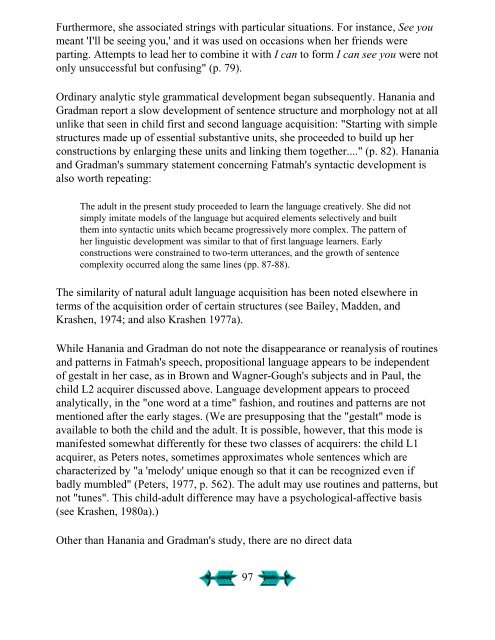Second Language Acquisition and Second ... - Stephen Krashen
Second Language Acquisition and Second ... - Stephen Krashen
Second Language Acquisition and Second ... - Stephen Krashen
Create successful ePaper yourself
Turn your PDF publications into a flip-book with our unique Google optimized e-Paper software.
Furthermore, she associated strings with particular situations. For instance, See you<br />
meant 'I'll be seeing you,' <strong>and</strong> it was used on occasions when her friends were<br />
parting. Attempts to lead her to combine it with I can to form I can see you were not<br />
only unsuccessful but confusing" (p. 79).<br />
Ordinary analytic style grammatical development began subsequently. Hanania <strong>and</strong><br />
Gradman report a slow development of sentence structure <strong>and</strong> morphology not at all<br />
unlike that seen in child first <strong>and</strong> second language acquisition: "Starting with simple<br />
structures made up of essential substantive units, she proceeded to build up her<br />
constructions by enlarging these units <strong>and</strong> linking them together...." (p. 82). Hanania<br />
<strong>and</strong> Gradman's summary statement concerning Fatmah's syntactic development is<br />
also worth repeating:<br />
The adult in the present study proceeded to learn the language creatively. She did not<br />
simply imitate models of the language but acquired elements selectively <strong>and</strong> built<br />
them into syntactic units which became progressively more complex. The pattern of<br />
her linguistic development was similar to that of first language learners. Early<br />
constructions were constrained to two-term utterances, <strong>and</strong> the growth of sentence<br />
complexity occurred along the same lines (pp. 87-88).<br />
The similarity of natural adult language acquisition has been noted elsewhere in<br />
terms of the acquisition order of certain structures (see Bailey, Madden, <strong>and</strong><br />
<strong>Krashen</strong>, 1974; <strong>and</strong> also <strong>Krashen</strong> 1977a).<br />
While Hanania <strong>and</strong> Gradman do not note the disappearance or reanalysis of routines<br />
<strong>and</strong> patterns in Fatmah's speech, propositional language appears to be independent<br />
of gestalt in her case, as in Brown <strong>and</strong> Wagner-Gough's subjects <strong>and</strong> in Paul, the<br />
child L2 acquirer discussed above. <strong>Language</strong> development appears to proceed<br />
analytically, in the "one word at a time" fashion, <strong>and</strong> routines <strong>and</strong> patterns are not<br />
mentioned after the early stages. (We are presupposing that the "gestalt" mode is<br />
available to both the child <strong>and</strong> the adult. It is possible, however, that this mode is<br />
manifested somewhat differently for these two classes of acquirers: the child L1<br />
acquirer, as Peters notes, sometimes approximates whole sentences which are<br />
characterized by "a 'melody' unique enough so that it can be recognized even if<br />
badly mumbled" (Peters, 1977, p. 562). The adult may use routines <strong>and</strong> patterns, but<br />
not "tunes". This child-adult difference may have a psychological-affective basis<br />
(see <strong>Krashen</strong>, 1980a).)<br />
Other than Hanania <strong>and</strong> Gradman's study, there are no direct data<br />
97











